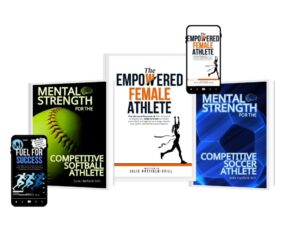Coaching female athletes requires more than just understanding the sport—it demands an awareness of the unique physiological and psychologic al factors that influence performance. In this blog I’ll cover what every coach needs to know about the female athlete’s hormonal cycle and coaching tips around the topic.
al factors that influence performance. In this blog I’ll cover what every coach needs to know about the female athlete’s hormonal cycle and coaching tips around the topic.
The athlete’s hormonal cycle is one such factor that, when understood, can unlock new levels of performance, improve athlete well-being, and reduce injury risks. Coaches who prioritize this understanding not only become better mentors but also create a supportive and inclusive environment where their athletes can thrive.
While some may see this as an uncomfortable topic, being proactive about understanding and addressing the implications of the hormonal cycle is critical. When coaches recognize what their female athletes experience, they’re better equipped to tailor training plans, provide emotional support, and foster trust within the team.
Understanding the Female Athlete’s Hormonal Cycle
The menstrual cycle is typically divided into four phases: the menstrual phase, follicular phase, ovulatory phase, and luteal phase. Each phase brings distinct hormonal changes that impact energy levels, performance capacity, mental focus, and susceptibility to injury. Here’s a breakdown:
1. Menstrual Phase (Day 1-5)
What happens: The cycle begins with menstruation, during which estrogen and progesterone levels are at their lowest. This can lead to fatigue and decreased energy levels. Some athletes may experience cramps, headaches, or other physical symptoms.
Performance implications: Energy may be lower during this phase, and athletes might benefit from moderate-intensity training rather than high-intensity efforts. However, many athletes report feeling capable and focused once physical symptoms subside.
Coaching tips:
- Allow flexibility in training based on how athletes feel.
- Encourage proper nutrition, hydration, and rest to counteract fatigue.
- Normalize conversations around this phase to reduce stigma and ensure athletes feel supported.
2. Follicular Phase (Day 6-14)
What happens: Estrogen levels begin to rise, peaking toward the end of this phase. This hormonal boost often correlates with increased energy, improved mood, and better recovery rates.
Performance implications: Athletes are often at their physical best during this phase, making it an ideal time for high-intensity training, strength building, and skill acquisition.
Coaching tips:
- Schedule demanding workouts, competitive events, or skill-based drills during this phase.
- Monitor recovery to take advantage of improved physical resilience.
3. Ovulatory Phase (Day 14)
What happens: Ovulation marks the release of an egg, and estrogen levels peak while progesterone begins to rise. Hormonal changes during this short phase can increase joint laxity, which heightens the risk of injuries such as ACL tears.
Performance implications: While athletes may feel strong and energized, the increased risk of injury requires caution.
Coaching tips:
- Incorporate neuromuscular training and exercises that improve stability and joint control.
- Emphasize proper warm-ups and cool-downs to reduce injury risks.
4. Luteal Phase (Day 15-28)
What happens: Progesterone dominates during this phase, while estrogen levels decline. This hormonal shift can lead to increased fatigue, water retention, and reduced coordination. Many athletes may experience premenstrual syndrome (PMS) symptoms such as irritability, mood swings, or difficulty concentrating.
Performance implications: Energy levels and performance capacity may dip, and recovery times may lengthen. Athletes may feel less motivated or experience physical discomfort.
Coaching tips:
- Prioritize lower-intensity sessions, active recovery, and skill refinement.
- Provide emotional support and encouragement to help athletes stay mentally engaged.
- Emphasize the importance of self-care, including adequate sleep and nutrition.
 Three Key Strategies for Coaches
Three Key Strategies for Coaches
1. Foster Open Communication
The first step in supporting female athletes is creating a culture where they feel comfortable discussing their menstrual health. When athletes feel safe sharing how they’re feeling, coaches can make informed decisions about training adjustments.
How to implement:
- Normalize conversations about the menstrual cycle during team meetings or one-on-one check-ins.
- Reassure athletes that their experiences are valid and that adjustments are a normal part of high-performance training.
Open communication reduces stigma, builds trust, and ensures athletes receive the individualized support they need.
2. Use Adaptive Training Plans
Be adaptable. You may have to throw out a training plan that day based on feedback and observation of your female athletes. Practice adapting workouts to match energy levels and physical resilience. When coaches do this, coaches can optimize performance and minimize injury risk.
How to implement:
- Schedule high-intensity or strength-based sessions during the follicular phase.
- Incorporate stability and injury-prevention exercises during the ovulatory phase.
- Focus on active recovery, mental skills, and skill work during the luteal phase.
Tailoring training to physiological changes helps athletes perform at their best while reducing overtraining and burnout.
3. Prioritize Mental Well-being
Hormonal fluctuations can affect mood, motivation, and focus. Coaches who support mental well-being help athletes stay resilient and engaged.
How to implement:
- Introduce mindfulness practices such as meditation, deep breathing, or journaling.
- Foster a sense of community through team-building activities.
- Validate athletes’ emotions and provide encouragement, especially during challenging phases.
Supporting mental wellness enhances self-confidence, focus, and the ability to handle pressure.
Empowering Female Athletes Through Awareness and Action
Understanding the female athlete’s hormonal cycle isn’t just about improving performance—it’s about empowering female athletes to embrace their unique strengths and challenges. Coaches who have this level of awareness and adapt their training methods and create a supportive environment not only elevate their athletes’ capabilities but also foster trust and confidence.
By recognizing and addressing the interplay between the hormonal cycle, performance, and well-being, coaches can unlock their athletes’ full potential and set them up for long-term success.
Check out my other blogs:
Coaching Female Athletes-The Art & Science
If you enjoyed this article and know other coaches and trainers who could benefit from the content in this blog, please share in your social media channels. When you share, female athletes benefit.
Julie Hatfield-Still

Julie is an Author, CEO and Coach. She is the President & Founder of the Non-Profit Beyond The Game Alliance where they offer a full suite of workshops for teams, coaches and parents. In addition to her work as a business consultant and coach of coaches, leaders and entrepreneurs. Julie is a Speed Development Specialist and Inner-Game Coach in the college, high school and youth levels.
addition to her work as a business consultant and coach of coaches, leaders and entrepreneurs. Julie is a Speed Development Specialist and Inner-Game Coach in the college, high school and youth levels.
Visit Julie’s Author Page

